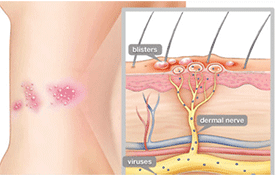Shingles and Postherpetic neuralgia
What causes postherpetic neuralgia?
Postherpetic neuralgia is a painful condition that affects the nerves of the skin. It is a complication of herpes zoster virus, commonly known as shingles. Shingles is a painful, blistering rash caused by reactivation of the virus called varicella-zoster, which people usually get during childhood (chickenpox). Once someone has had chickenpox, the virus that caused it can remain dormant in some of the body’s nerve cells. As people age, the virus can reactivate. The result is a shingles rash. Since there is some immunity against the virus, rather than a full body rash, the rash occurs in areas of skin supplied by the nerve where the virus is reactivated. Pain that persists long after the shingles rash and blisters have disappeared is called postherpetic neuralgia. It occurs when a person’s nerves are damaged during the shingles outbreak. The damaged nerves cannot send messages from the skin to the brain correctly, and they become confused. This results in chronic severe pain that can last for months, or even years.
The risk of getting shingles as well as postherpetic neuralgia increases with age, and is more likely to occur in people over the age of 60.
Clinical symptoms and signs of Post Hepatic Neuralgia
The signs and symptoms of postherpetic neuralgia are generally limited to the area if skin where the shingles outbreak first occurred. Signs and symptoms include pain commonly described as burning, sharp and stabbing, or deep and aching. Symptoms also include sensitivity to light touch or temperature changes
Upon examination of the patient, there may be evidence of scar formation on the skin at the site that had been recently affected by herpes zoster.
Diagnosis
The best way to diagnose postherpetic neuralgia is through clinical history and examination. Rarely are additional investigations such as a viral culture or antibody measurements towards herpes zoster virus required.
Treatment of Postherpetic neuralgia
 Currently, there is no cure or postherpetic nerualiga. Treatment aims to control and reduce pain until the condition goes away. Pain management may include:
Currently, there is no cure or postherpetic nerualiga. Treatment aims to control and reduce pain until the condition goes away. Pain management may include:
Analgesics are medications that are specifically used to relieve pain. They are also known as painkillers. Common analgesics for postherpetic neuralgia include:
-
- Capsaicin cream, an analgesic extracted from hot chilli peppers
- Lidocaine patches have been recently shown in clinical studies to offer patients significant pain relief.
- Over-the-counter medications such as Acetaminophen or Ibuprofen
- Stronger prescription medications such as codeine, hydrocodone, or oxycodone
Tricyclic Antidepressants (TCA) are normally prescribed to treat depression, however they appear to have a powerful analgesic effect and can reduce pain associated with postherpetic neuralgia. They often have side effects, like dry mouth and blurred vision. Commonly used TCA’s include:
-
- amitriptyline (Elavil)
- desipramine (Norpramin)
- imipramine (Tofranil)
- nortriptyline (Pamelor)
Anticonvulsants are normally used for seizures. However studies have shown that lower doses can be effective in treating the pain of postherpetic neuralgia as well. They work by altering the conduction of pain impulses along the nerve fibres and also have a mild sedative effect, both of which can help control pain effectively.
-
- carbamazepine (Tegretol)
- gabapentin (Neurontin)
- phenytoin (Dilantin)
Can Postherpetic Neuralgia be prevented?
A herpes zoster vaccine called Zostavax can reduce the risk of shingles by 50%. It can also protect against postherpetic neuralgia. The vaccine is given to all adults over the age of 60.



